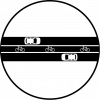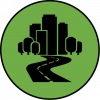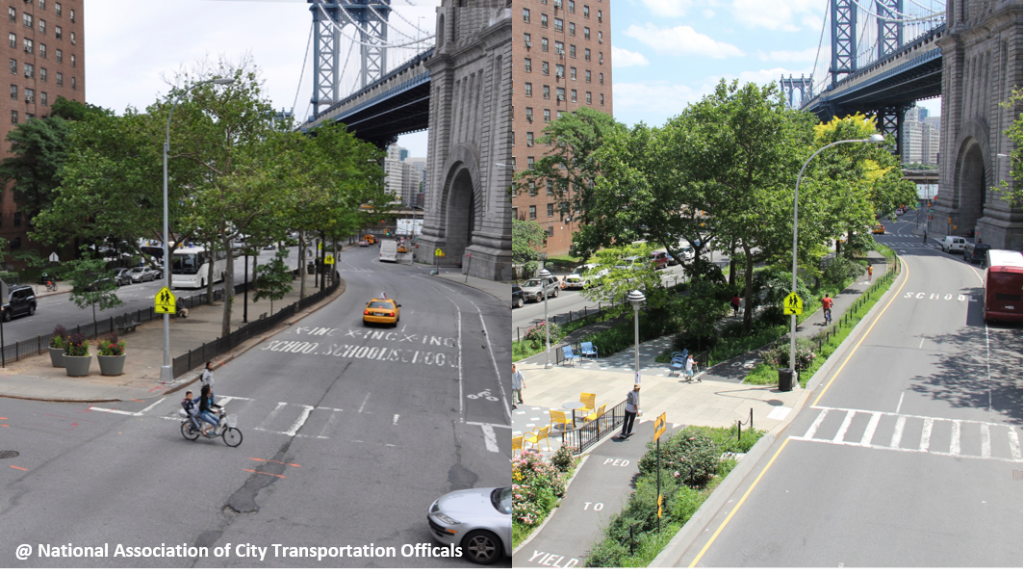
1. Presentation
This measure narrows the width of the entire roadway, resulting in the reduction of speed and volume of motorized vehicles and in the increase of safety for other transport modes.
2. Objectives
- Reducing the speed of motorized vehicles in order to allow the shared use of roadways by different transport modes.
- Improving safety for cyclists.
3. Measure’s Importance
Several studies have shown that motorized traffic is the biggest barrier to cycling mobility. Traffic calming and speed reduction are essential to promote bicycle use, as they decrease the need to segregate the bicycle, fostering equality between motorized and non-motorized modes of transport in the same physical context.
1. Good Practices
– This measure is indicated for roadways that exceed the maximum width defined by the national mobility authorities (IMT in the Portuguese case) according to road hierarchy. This is particularly important for local roads, since the profile in those roads should be adapted to low-speeds and to be compatible with other modes of transport.
– Work with experts with up-to-date knowledge of the measures and designs in use.
– Use different types of traffic calming measures and different actions within each measurement (See Horizontal and vertical road deflections, Limited speed zones, Car connectivity restrictions).
– Design the intervention taking into account that streets are used for various purposes, namely, travelling, sightseeing, socializing, trading and living, in the sense that the streets are the entrance spaces for the dwellings. As such, interventions should be designed to improve the aesthetics and comfort of pedestrians and cyclists, besides reducing the speed of motor vehicles.
– STOP signs should not be used as a means of traffic calming.
– New interventions should receive extra signage to alert the new conditions. After a few years, the extra signals can be removed.
– Monitor citizens’ adaptation to changes and reformulate measures to respond to users’ needs, without compromising sustainable ideals (See Management, monitoring and maintenance).
– Explain the principles behind the measures taken so that their need and functioning are clear (See Information).
2. Actions
 | Central reservation Road narrowing through the introduction of a median strip which may include green areas, bike paths, parking, etc. Advantages: Key measure to promote traffic calming and to ensure space for soft modes. |
 | Road narrowing Roadway capacity for car use is reduced. In the intervened roads the sidewalk is extended and/or bike paths, public transport routes, green spaces or parking are introduced. These measures generally aim not only to reduce the traffic volume but also to encourage the use of public transport and soft modes. |
 | Introduction of obstacles The width of the roadway is narrowed by introducing obstacles such as flower beds or road posts. Advantages: Does not require complex infrastructure, reducing implementation costs. |
“The power of paint”: The City of Fortaleza, Brazil, launched a new Cidade da Gente (City of People) project in Dragão do Mar in August 2018. City contractors and local volunteers applied bright colours and bold patterns to the 5,000 square meter site over three days, and used 1,000 litres of paint to improve the streets’ geometry. The redesign makes streets safer and brings revived life and energy to the neighbourhood.
1. Impacts
 | Mobility system efficiency The measure is detrimental to car, discouraging its use and promoting alternative modes of transport, which tends to increase the efficiency of the mobility system. However, by reducing traffic speed and volume, it can also generate some congestion points. |
 | Livable streets The interventions require the redesign of public space in order to reduce conflicts between vehicles, pedestrians and cyclists. Facilitating the movement of active modes and the sharing of space between different users promotes the humanization of the city. |
 | Protection of the environment Studies indicate that traffic calming measures favour the modal shift from the car to the bicycle, which reduces air and noise pollution. |
 | Inclusion, equity and accessibility Traffic calming measures ensure the improvement of accessibility and travel options for users of alternative modes of transport. |
 | Safety and comfort By reducing car speed and increasing the visibility of pedestrians and cyclists, the streets become safer and more comfortable for all. |
 | Economic value The measure promotes a more attractive access to local shops and services by improving safety and environmental quality. However, traffic calmed areas can also be less attractive for car users, reducing accessibility for visiting traffic. |
 | Awareness and acceptability The provision of traffic calming measures promotes greater use of the bicycle, which may influence more sceptical groups to use the bicycle more often. |
Legend:
| Very positive | Positive | Neutral | Negative | Very negative |
2. Barriers
 | Legal Countries where there is no legal framework or guidance on traffic calming may face legal barriers. |
 | Finance Costs change depending on the degree of intervention. The more complex the materials used and the redesign of the urban space, the higher the cost. |
 | Governance Traffic calming can usually be implemented by a single public department. |
 | Political acceptability Measures focused on reducing the car competiveness often have little priority within policymaking. |
 | Public acceptability The citizens who live or often use the treated area may raise some opposition. Aesthetics and the precise location of calming measures are often important influences on acceptance. Some surveys show that the majority of those living in traffic calmed areas are satisfied with the measure. |
 | Technical feasibility Some traffic calming measures require specific technical know-how. |
Legend:
| No barrier | Minimum barrier | Moderate barrier | Significant barrier |
3. Budget
Costs vary depending on the implemented actions. The road narrowing through the introduction of sidewalks or cycle paths requires more materials and specialized technical know-how, both on the comfort of the new lanes and on the application of the materials.
The introduction of cycle lanes is less expensive in terms of materials, but needs the same attention to comfort and safety as cycle tracks.
The placement of obstacles varies in cost depending on the materials used. It must be borne in mind that more resistant materials will require less maintenance in the future. They also provide more safety when used as a barrier to separate cyclists and/or pedestrians.
(See Cycling network)
Case study 1: Improvements on Allen and Pike streets, New York (U.S.A.)

On Allen and Pike streets, the central reservation dividing 6 lanes was widened to create quality public space and provide a properly located cycle track. In addition to the reduction from 6 lanes to 4, the connectivity of private cars was restricted without compromising public transport and the conditions at crossings were improved to accommodate cyclists and pedestrians. The project resulted in fewer accidents, leading to planning new improvements, including one more cycle path in the opposite direction and the introduction of flowerbeds to protect them.
Impact:
 | Mobility system efficiency By reducing the volume of private cars without compromising public transport and benefiting cycling, the project has improved the efficiency of the mobility system in general. |
 | Livable streets The space of the central reservation has been used to the maximum, not only to narrow the roadway, but also to create a quality community space. Vegetation, street furniture, pedestrian lighting and comfortable pavement were introduced to create a pleasant, livable, area. |
 | Protection of the environment By reducing the traffic volume and adding trees along the roadway, emissions of polluting gases have been reduced. |
 | Inclusion, equity and accessibility The design of the intervention provided equal space for the various users and transport modes. |
 | Safety and comfort The changes have created more comfortable and safe spaces for pedestrians and cyclists, leading to a 12% reduction in the number of injuries. |
 | Economic value No data. |
 | Awareness and acceptability Since the measure included the creation of a cycle path, with adequate safety conditions, it contributes to the dissemination of cycling and to a greater awareness of its benefits. |
Legend:
| Very positive | Positive | Neutral | Negative | Very negative |
Daily Mail (2010). Stop speeding… the DIY way: Plant pots, welcome mats and drawings slow cars. Accessed 9 July 2019. Available at: https://www.dailymail.co.uk/news/article-1326361/Stop-cars-speeding-DIY-way-using-plant-pots-drawings-road.html
IMTT (2011). Princípios de Planeamento e Desenho. Colecção de Brochuras Técnicas / Temáticas Rede Ciclável . Accessed 2 July 2019. Available at: http://www.imt-ip.pt/sites/IMTT/Portugues/Planeamento/DocumentosdeReferencia/PacotedaMobilidade/Documents/Pacote%20da%20Mobilidade/Rede%20Cicl%C3%A1vel_Princ%C3%ADpios%20de%20Planeamento%20e%20Desenho_Mar%C3%A7o%202011.pdf
InIR. Instituto de Infraestruturas Rodoviárias. (2011). Medidas de Acalmia de Tráfego (Vol.1) – Medidas Individuais Aplicadas em Atravessamentos de Localidades, Disposições Normativas. Accessed 3 July 2019. Available at: http://www.imt-ip.pt/sites/IMTT/Portugues/InfraestruturasRodoviarias/InovacaoNormalizacao/Divulgao%20Tcnica/MedidasAcalmiaTrafegoVol1.pdf
ITE/FHWA. (1999). Traffic Calming: State of the Practice. Accessed 3 July 2019. Available at: http://www.industrializedcyclist.com/trafficcalming.pdf
Juhász, M., & Koren, C. (2016). Getting an insight into the effects of traffic calming measures on road safety. Transportation Research Procedia, 14, 3811–3820. Accessed 6 February 2019. Available at: https://doi.org/10.1016/j.trpro.2016.05.466
KonSULT. Knowledgebase on Sustainable Urban Land use and Transport. (2014). Traffic Calming Measures. Accessed 9 July 2019. Available at: http://www.konsult.leeds.ac.uk/pg/13/
Mertens, L. et al., 2017. Built environmental correlates of cycling for transport across Europe. Health & Place, pp. 35-42.
McGrane, A. (2013) Allen and Pike Streets Corridor Improvements. PEDSAFE 2013 – Pedestrian Safety Guide and Countermeasure Selection System. Accessed 18 June 2019. Available at: pedbikesafe.org/PEDSAFE/casestudies_detail.cfm?CM_NUM=19&CS_NUM=72
NACTO. National Association of City Transportation Officials. (2013). Urban Street Design Guide. Accessed 6 February 2019. Available at: https://nacto.org/publication/urban-street-design-guide/
NEITE. New England Institute of Transportation Engineers. (2016). Traffic Calming. Accessed 6 February 2019. Available at: http://neite.org/wp-content/uploads/2016/10/NEITE-Final-Traffic-Calming-Guidelines-6-30-2016.pdf
Global Road Safety Partnership. (2008). Speed management: a road safety manual for decision-makers and practitioners. Accessed 3 July 2019. Available at: https://www.who.int/roadsafety/projects/manuals/speed_manual/en/
Pedestrian Liberation (2012). DIY traffic calming in Beech Croft Road, Oxford. Accessed 9 July 2019. Available at: https://pedestrianliberation.org/2012/07/09/diy-traffic-calming-in-beech-croft-road-oxford/
Pereira, P. C. (2014). Devolver as Cidades às Pessoas. Accessed 6 February 2019. Available at: http://transportesemrevista.com/Default.aspx?tabid=210&language=pt-PT&id=40088
Pereira, J. (2013). Medidas de acalmia de tráfego em áreas urbanas consolidadas: Um caso no concelho do Seixal. (Master thesis) Faculdade de Ciências Sociais e Humanas da Universidade Nova de Lisboa e Universidade Atlântica, Lisbon. Accessed 6 July 2019. Available at: https://run.unl.pt/bitstream/10362/12093/1/Medidas%20de%20acalmia%20de%20tr%C3%A0fego%20em%20%C3%A1reas%20urbanas%20consolidadas_.pdf
PPS. Project for Public Spaces. (2008). Traffic calming 101. Accessed 6 February 2019. Available at: www.pps.org/article/livememtraffic.
Seco, Á., Ribeiro, A., Macedo, J., & Silva, A. B. (2008). Acalmia de tráfego – Manual do Planeamento de Acessibilidades e Transportes.
Victoria Transport Policy Institute (2018). Traffic Calming. Online Transportation Demand Management (TDM) Encyclopedia. Accessed 18 June 2019. Available at: www.vtpi.org/tdm/tdm4.htm
Vieira, D. (2008). Medidas de Acalmia de Tráfego em Zonas Residenciais. (Master thesis). Faculdade de Engenharia da Universidade do Porto, Porto.
